-
- PCB TYPE
- PRINTED CIRCUIT BOARD PROTOTYPE ALUMINUM PRINTED CIRCUIT BOARD R&F PCB FPC HIGH FREQUENCY PCB HIGH-TG PCB HEAVY COPPER PCB HDI PCB PCB FOR LIGHTING METAL CORE PCB
In the fast-paced evolution of electronic engineering, aluminum printed circuit boards (PCBs) have emerged as a transformative technology, offering a unique combination of thermal efficiency, mechanical robustness, and design versatility. These PCBs leverage the inherent properties of aluminum to address the critical challenges of heat management, compact form factors, and reliable operation in diverse environments, making them indispensable across industries from lighting to aerospace. This article provides a comprehensive overview of aluminum PCBs, exploring their material science, design principles, manufacturing processes, industrial applications, and emerging trends, while highlighting their role in enabling the next generation of high-performance electronics.
The Foundation of Aluminum PCBs: Material Science
Aluminum Substrate: A Multifunctional Core
The aluminum substrate lies at the heart of these PCBs, serving as a foundational layer with distinct advantages:
Exceptional Thermal Conductivity: Aluminum’s high thermal conductivity allows for rapid dissipation of heat generated by power-hungry components, preventing thermal stress and ensuring stable operation. This is particularly crucial for devices where overheating could lead to performance degradation or component failure.
Mechanical Resilience: Aluminum alloys offer a favorable strength-to-weight ratio, making them resistant to bending, vibrations, and shocks. This mechanical durability is essential for applications in harsh environments, such as automotive, industrial, and aerospace systems.
Cost-Effective Formability: Aluminum’s malleability enables the creation of complex shapes and thin profiles, accommodating the compact designs demanded by modern electronics while maintaining structural integrity.
Dielectric Layers: Balancing Insulation and Heat Transfer
The dielectric layer in aluminum PCBs plays a dual role, separating the aluminum substrate from copper conductive layers while facilitating heat transfer:
Electrical Insulation: Ensures no short circuits between the aluminum core and copper traces, maintaining the integrity of electrical signals.
Thermal Interface: High-quality dielectric materials, such as ceramic-filled epoxies or polyimides, enhance heat transfer from components to the aluminum substrate, optimizing thermal management without compromising electrical performance.
Copper Layers: Conductive Pathways for Signal and Power
Copper, with its low electrical resistance, forms the conductive layers of aluminum PCBs:
Signal Traces: Designed to carry low-current signals with minimal loss, critical for high-frequency applications such as wireless communication and sensor networks.
Power Traces: Thicker copper foils are used for power distribution, reducing resistance and heat generation in high-current paths, the crucial in power electronics and motor control systems.
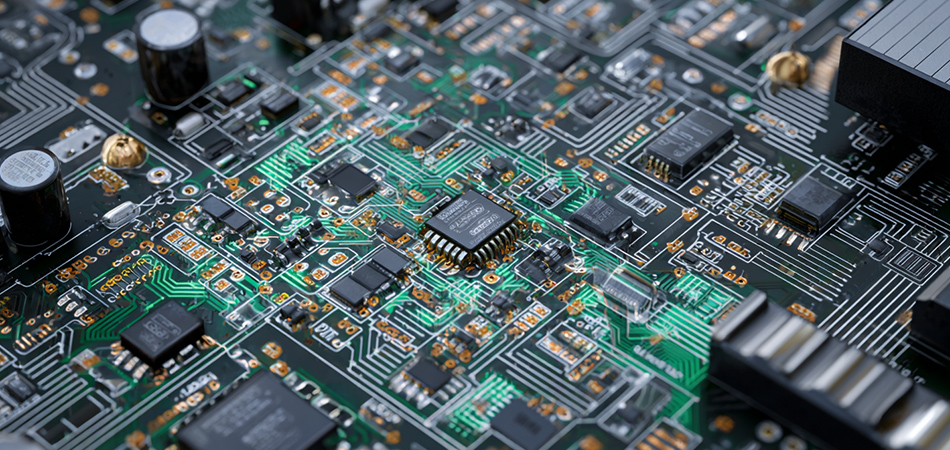
Design Principles for Aluminum PCBs
Thermal Management: The Critical Design Focus
Effective heat dissipation is the cornerstone of aluminum PCB design, involving strategic component placement and thermal pathway optimization:
Component Placement: Heat-generating components like power transistors, LEDs, and microprocessors are positioned to maximize contact with the aluminum substrate, allowing direct heat transfer. Thermal vias, which connect copper layers to the aluminum core, are strategically placed to create efficient heat dissipation paths.
Heat Sink Integration: The aluminum substrate can act as a natural heat sink, or it can be paired with external heat sinks for enhanced cooling. This is particularly important in high-power applications where maintaining optimal component temperatures is essential for longevity and performance.
Electrical Design: Signal Integrity and Power Efficiency
Trace Routing: High-speed signals are routed to minimize interference, with controlled impedance traces ensuring signal integrity in applications such as high-frequency data transmission. Power traces are designed to handle current loads efficiently, reducing voltage drops and energy loss.
Ground Plane Design: A solid ground plane on one or both sides of the PCB provides a stable reference for signals, reducing electromagnetic interference (EMI) and improving noise immunity in mixed-signal circuits.
Mechanical Design: Durability and Form Factor
Substrate Thickness: Tailored to application needs, with thinner substrates enabling compact, lightweight designs for portable devices and thicker substrates providing enhanced heat capacity for industrial power modules.
Mounting Solutions: Reinforced mounting holes and mechanical fixtures ensure the PCB remains secure in vibration-prone environments, while conformal coatings protect against moisture, dust, and chemical contaminants in harsh operating conditions.
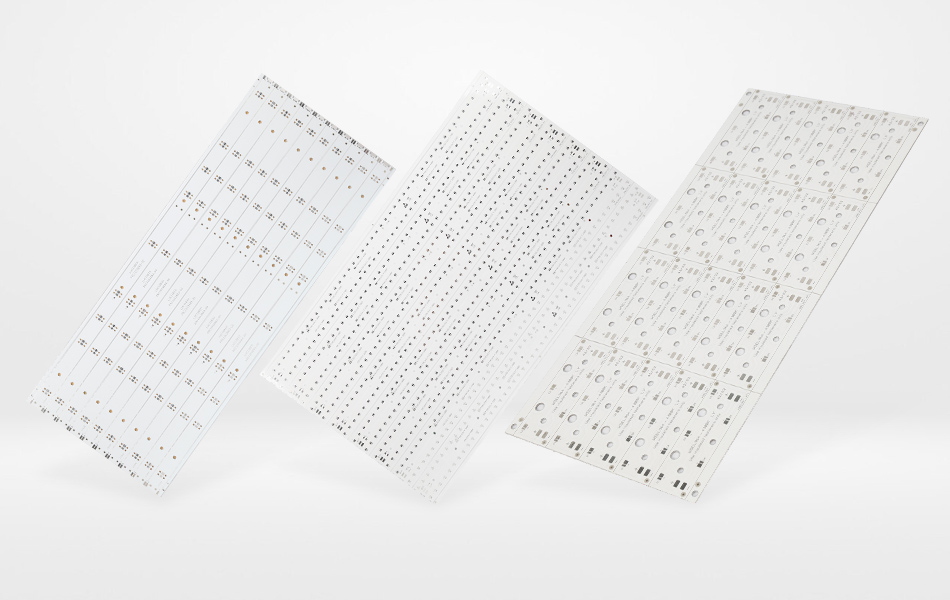
Manufacturing Processes for Aluminum PCBs
Substrate Preparation
Material Cutting: Aluminum substrates are precision-cut using CNC milling or laser cutting to exact dimensions, followed by surface treatments to enhance the adhesion of dielectric layers and improve corrosion resistance.
Surface Treatment: Processes such as degreasing and micro-etching prepare the aluminum surface for lamination, ensuring a strong bond with dielectric materials and optimal thermal conductivity.
Layer Lamination
Dielectric Bonding: High-pressure lamination processes bond dielectric layers to the aluminum substrate, creating a stable base for copper layers. This step is critical for maintaining thermal and electrical performance, with automated presses controlling temperature and pressure to ensure uniform bonding.
Copper Layer Fabrication
Foil Lamination: Electrolytic copper foil is laminated to the dielectric layers, followed by photolithography or laser direct imaging (LDI) to transfer circuit patterns. LDI is particularly useful for fine-pitch traces in high-density designs, ensuring precise feature sizes and spacing.
Chemical Etching: Unwanted copper is removed using chemical etching, with post-etch inspection via automated optical inspection (AOI) to ensure trace integrity and eliminate defects.
Surface Finishing
Protective Coatings: Surface finishes such as electroless nickel immersion gold (ENIG), organic solderability preservative (OSP), or hot air solder leveling (HASL) are applied to copper traces to enhance solderability and corrosion resistance, depending on the application’s requirements.
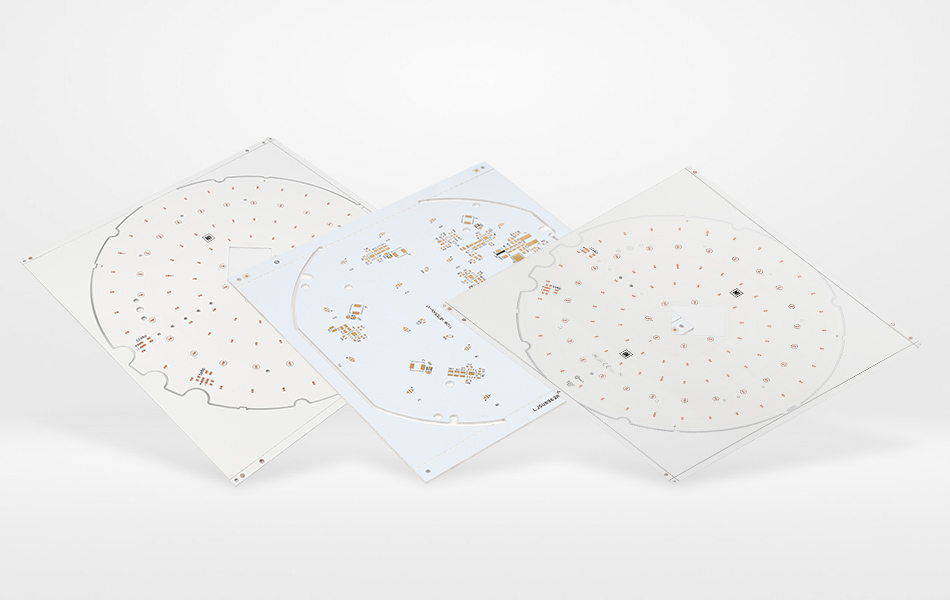
Industrial Applications of Aluminum PCBs
LED Lighting Systems
Commercial and Residential Lighting: Aluminum PCBs are widely used in LED panels, downlights, and linear fixtures, efficiently dissipating heat from LED arrays to maintain consistent light output and extend lifespan. Their formability allows for custom shapes in architectural lighting, while their thermal efficiency is crucial for high-brightness applications.
Automotive Lighting: In headlamps, taillights, and interior lighting, aluminum PCBs enable compact designs with reliable heat management, even in the temperature-sensitive environment of vehicle interiors.
Power Electronics
Power Supplies and Inverters: Aluminum PCBs handle the high currents and heat generated by power semiconductors in inverters for renewable energy systems and DC-DC converters, ensuring efficient power conversion and stable operation.
Battery Management Systems (BMS): Used in electric vehicles and energy storage systems to monitor and control battery cells, with thermal management critical to preventing thermal runaway and ensuring safety.
Automotive Electronics
Engine Control Units (ECUs): Operate reliably in the harsh environment of engine bays, with aluminum’s thermal and mechanical properties resisting high temperatures, vibrations, and moisture.
Advanced Driver-Assistance Systems (ADAS): Support high-speed data processing and sensor integration in ADAS modules, with aluminum PCBs enabling compact layouts and efficient heat dissipation from image processors and radar components.
Consumer Electronics
Portable Devices: Laptops, tablets, and gaming consoles use aluminum PCBs to manage heat from high-performance processors, enabling slim designs without compromising performance.
Wearable Technology: Smartwatches and fitness trackers rely on lightweight aluminum PCBs to integrate sensors, batteries, and wireless modules in compact form factors, balancing thermal efficiency with comfortable wear.
Industrial Control and Automation
Motor Drives and Robotics: Aluminum PCBs withstand the vibrations and high temperatures of industrial environments, supporting reliable operation of motor control circuits and robotic controllers.
Process Control Systems: Used in sensors and control panels for real-time monitoring in manufacturing plants, with conformal coatings protecting against dust and moisture.
Aerospace and Defense
Avionics Systems: Critical for navigation and communication modules in aircraft, where aluminum PCBs provide lightweight, high-reliability solutions that can withstand extreme temperatures and mechanical stress.
Military Electronics: Used in ruggedized devices such as portable radios and missile systems, combining thermal stability with resistance to shock and vibration.
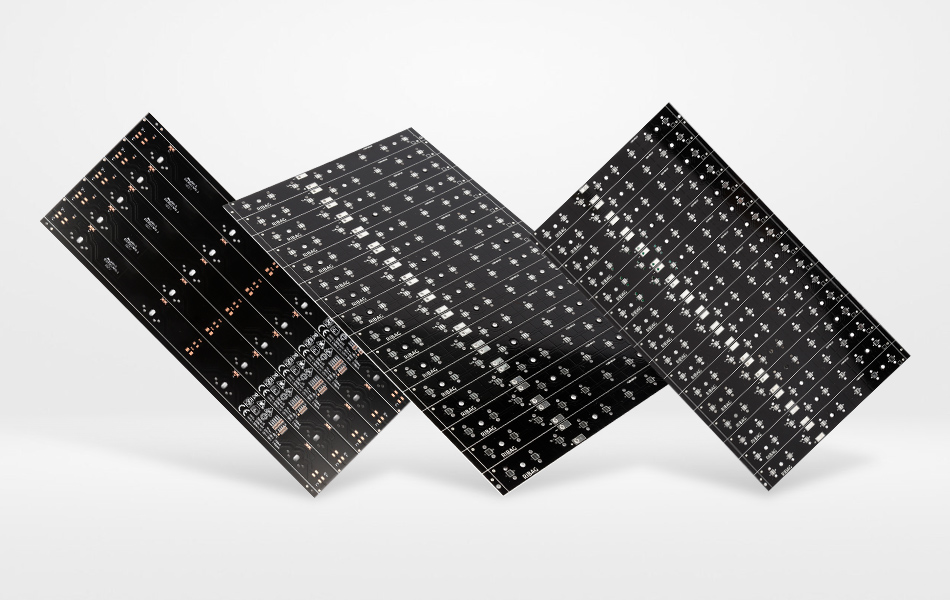
Emerging Trends in Aluminum PCB Technology
Miniaturization and High-Density Integration
Microvia Technology: Laser-drilled microvias and fine-pitch traces enable high-density interconnects in compact devices such as IoT sensors and 5G modules, where every millimeter of board space is valuable.
3D Packaging: Aluminum PCBs facilitate vertical integration of components, creating 3D systems with enhanced thermal and electrical performance, ideal for advanced mobile devices and embedded systems.
Sustainable Manufacturing Practices
Eco-Friendly Materials: The industry is moving towards recycled aluminum substrates and water-based dielectric adhesives, reducing the environmental footprint while maintaining performance.
Energy-Efficient Processes: Low-temperature lamination and lead-free surface finishes align with global sustainability goals, ensuring aluminum PCBs are produced with minimal environmental impact.
Advanced Thermal Solutions
Hybrid Substrates: Composite materials combining aluminum with high-thermal-conductivity layers such as graphite or carbon fiber enhance heat dissipation, enabling higher power densities in applications like 5G power amplifiers and high-performance computing.
Phase-Change Materials (PCM): Integration of PCMs with aluminum PCBs provides passive thermal regulation, absorbing and releasing heat to maintain component temperatures within tight ranges in extreme environments.
Automation and Digital Design Tools
AI-Powered Design: Machine learning algorithms optimize component placement and thermal via routing, reducing design time and improving thermal performance in complex layouts.
Robotic Assembly: High-precision robotic systems ensure accurate component placement and soldering, improving yield in high-volume production and enabling micro-pitch applications.
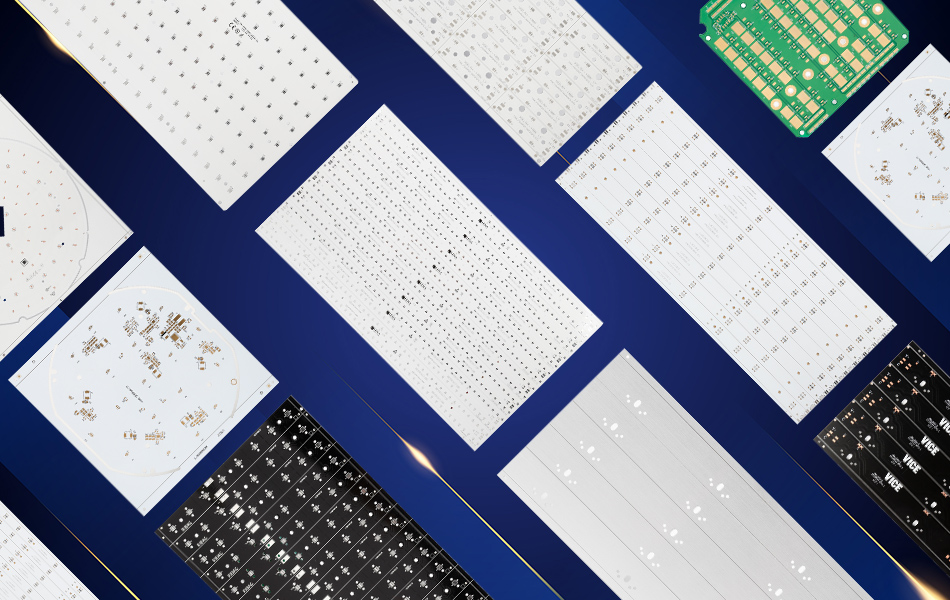
Conclusion
Aluminum PCBs have revolutionized the electronics industry by offering a robust solution to the challenges of heat management, mechanical durability, and design flexibility. Their ability to support a wide range of applications, from everyday consumer devices to critical aerospace systems, highlights their versatility and importance in modern electronics. As technology continues to advance towards miniaturization, sustainability, and higher power densities, aluminum PCBs will evolve through material innovation, advanced manufacturing techniques, and 智能化 design tools. For engineers and designers, leveraging the unique advantages of aluminum PCBs is essential for creating reliable, efficient, and future-ready electronic systems that meet the demands of an increasingly connected and performance-driven world. By combining the natural strengths of aluminum with cutting-edge engineering, these PCBs are set to remain a cornerstone of high-performance electronics for years to come.
In the rapidly evolving landscape of electronic design, prototyping plays a critical role in transforming conceptual ideas into functional solutions. Among the diverse range of printed circuit board (PCB) technologies, 2 layer aluminum PCBs have emerged as a preferred choice for prototyping applications that demand a balance of thermal efficiency, mechanical robustness, and cost - effectiveness. This article explores the engineering principles, design considerations, manufacturing processes, and real - world applications of 2 layer aluminum PCB prototypes, providing insights into their role in modern electronic development.
Fundamentals of 2 Layer Aluminum PCBs
Structural Overview
A 2 layer aluminum PCB prototype consists of two primary conductive layers—top and bottom—separated by a dielectric layer bonded to an aluminum substrate. The aluminum base serves as both a mechanical support and a thermal dissipater, while the two copper layers handle signal transmission and power distribution. This simple yet effective structure makes it ideal for applications where moderate complexity and efficient heat management are required without the added cost and complexity of multi - layer designs.
The aluminum substrate, typically composed of alloys like 6xxx series, offers a combination of high thermal conductivity and mechanical strength. The dielectric layer, often a ceramic - filled epoxy or polyimide, provides electrical insulation while facilitating heat transfer from the copper traces to the aluminum base. This dual - layer configuration strikes a balance between performance and simplicity, making it a versatile choice for prototyping across industries.
Key Advantages for Prototyping
Thermal Efficiency: The aluminum substrate efficiently dissipates heat generated by components, preventing thermal stress that could compromise prototype functionality during testing. This is particularly important for power - intensive components like LEDs, voltage regulators, or microprocessors.
Cost - Effectiveness: Compared to multi - layer PCBs, 2 layer designs reduce material and manufacturing costs, making them suitable for initial design iterations where budget and time are critical.
Design Flexibility: The two - layer layout allows for straightforward component placement and trace routing, enabling rapid design modifications during the prototyping phase.
Mechanical Durability: The aluminum substrate provides robust mechanical support, resisting bending and vibrations, which is essential for prototypes tested in real - world environments.
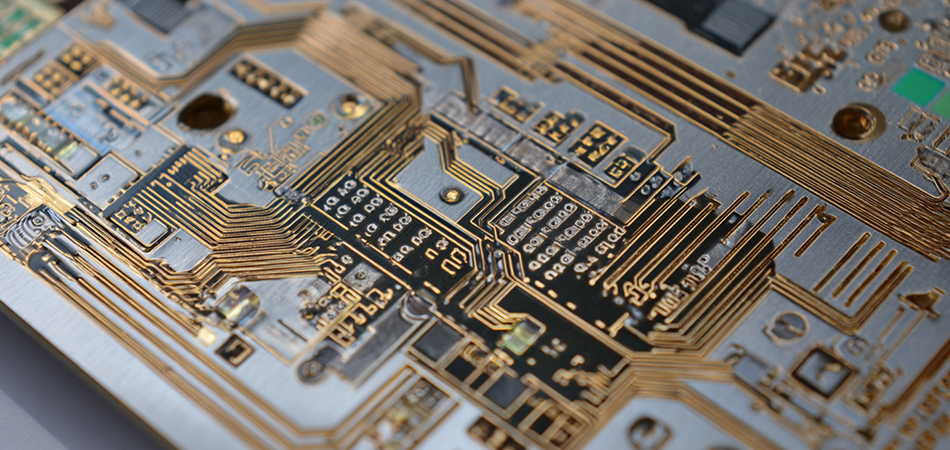
Design Considerations for 2 Layer Aluminum PCB Prototypes
Thermal Management Strategies
Component Placement
In 2 layer aluminum PCB prototypes, heat - generating components should be positioned on the top layer, directly above the aluminum substrate, to maximize heat transfer. Thermal vias—through - holes connecting the top copper layer to the aluminum base—are strategically placed around these components to create direct thermal pathways. The density and size of vias are optimized based on the component's power dissipation, with larger or more numerous vias used for higher - power devices.
Heat Sink Integration
For applications requiring enhanced thermal performance, the bottom layer of the PCB can be used to mount heat sinks or thermal pads. The aluminum substrate acts as a natural heat spreader, distributing heat across the board and into the heat sink, which is particularly effective in prototyping high - power LED fixtures or small - scale power supplies.
Electrical Design Principles
Trace Routing
In a 2 layer design, the top layer is typically used for signal traces and components, while the bottom layer serves as a ground plane or power distribution layer. This separation reduces electromagnetic interference (EMI) and provides a stable reference for signal integrity. High - speed signals should be routed on the top layer with controlled impedance, while the bottom layer's solid ground plane helps minimize noise.
Power Distribution
Power traces on the top layer are designed with sufficient width to handle the required current, avoiding voltage drops and excessive heating. The bottom layer can be used for distributing ground signals or low - voltage power, creating a balanced power - ground plane that improves overall circuit stability.
Mechanical Design Factors
Substrate Thickness
The thickness of the aluminum substrate is chosen based on the prototype's mechanical and thermal requirements. A thicker substrate offers greater mechanical strength and heat capacity, while a thinner substrate allows for more compact designs, suitable for portable or space - constrained applications.
Mounting and Form Factor
Mounting holes are incorporated into the design to secure the prototype within enclosures or test fixtures. The form factor—size and shape of the PCB—is optimized for the target application, with considerations for edge clearance, component spacing, and compatibility with mechanical interfaces.
Dielectric Layer Selection
Ceramic - filled epoxies are often preferred for dielectric layers in 2 layer prototypes due to their cost - effectiveness and balanced thermal - electrical properties. They offer better thermal conductivity than traditional FR4 dielectrics, ensuring efficient heat transfer to the aluminum substrate while providing adequate electrical insulation for most prototyping needs. Polyimide dielectrics may be used for high - temperature prototypes, such as those tested in industrial or automotive environments.
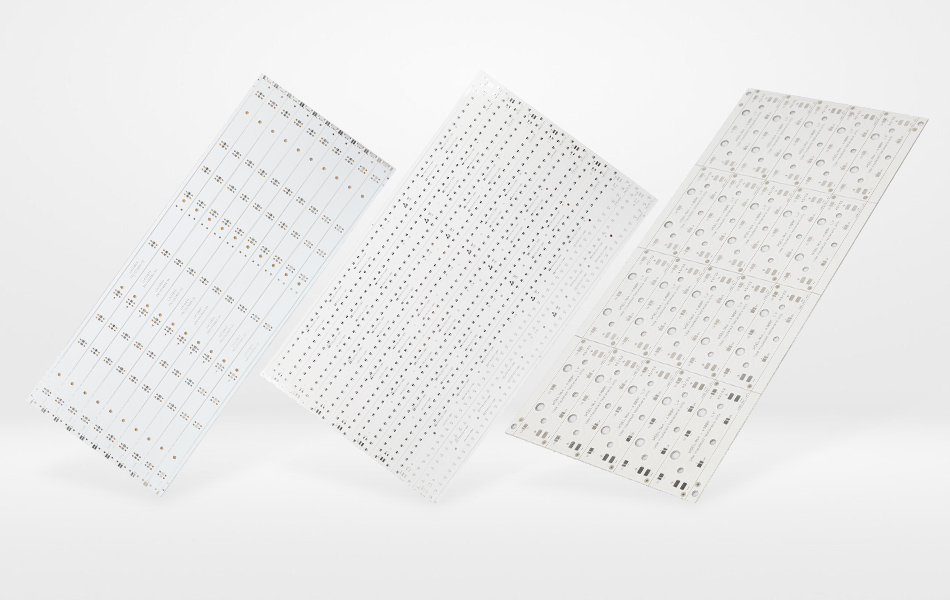
Manufacturing Processes for 2 Layer Aluminum PCB Prototypes
Design and Layout
CAD Tools
Designers use specialized software like Altium Designer, KiCad, or Eagle to create 2 layer layouts, ensuring proper component placement, trace routing, and thermal via positioning. These tools allow for thermal simulation to predict heat distribution and make iterative design improvements before manufacturing.
Gerber File Preparation
Gerber files, containing detailed layer information, are generated and verified for accuracy. Special attention is paid to thermal via placement and pad shapes to ensure proper heat dissipation and component soldering.
Material Preparation
Aluminum Substrate Cutting
The aluminum substrate is cut to the specified dimensions using CNC milling or laser cutting, ensuring precise edges and hole placement. The surface is cleaned and prepared to ensure proper adhesion of the dielectric layer and copper foil.
Dielectric Layer Lamination
A pre - cured dielectric sheet, either a ceramic - filled epoxy or polyimide, is laminated to the aluminum substrate using high - pressure and temperature processes. This creates a stable base for the copper layers, ensuring uniform thickness and thermal conductivity.
Copper Layer Fabrication
Copper Foil Lamination
Copper foil is laminated to both sides of the dielectric - coated aluminum substrate. The foil thickness is selected based on current requirements, with thicker foil used for power - intensive prototypes.
Photolithography and Etching
Photolithography is used to transfer the circuit design onto the copper foil. The exposed copper is etched away using chemical solutions, leaving the desired trace patterns on both the top and bottom layers. This process requires precision to ensure accurate trace widths and spacing, especially for fine - pitch components.
Via and Hole Formation
Drilling and Plating
Thermal vias and mounting holes are drilled using mechanical or laser drilling. Mechanical drilling is suitable for larger holes, while laser drilling offers precision for small vias. After drilling, the holes are plated with copper to ensure electrical connectivity between the top and bottom layers, with special attention to thermal vias to maximize heat transfer.
Surface Finishing
Options for Prototyping
Organic Solderability Preservative (OSP): A cost - effective option for prototyping, providing a thin organic layer that protects copper from oxidation and ensures good solderability.
Electroless Nickel Immersion Gold (ENIG): Used for prototypes requiring high - reliability connections, such as those with fine - pitch components or exposed contacts.
Hot Air Solder Leveling (HASL): A traditional finish suitable for prototypes where cost and ease of soldering are priorities.
Prototyping-Specific Considerations
Rapid prototyping services often use accelerated manufacturing processes, such as:
Laser Direct Imaging (LDI): For faster and more accurate pattern transfer, reducing lead times for small - batch prototypes.
Quick - Turn Lamination: Specialized presses that cure dielectric layers in shorter cycles, ideal for urgent prototype orders.
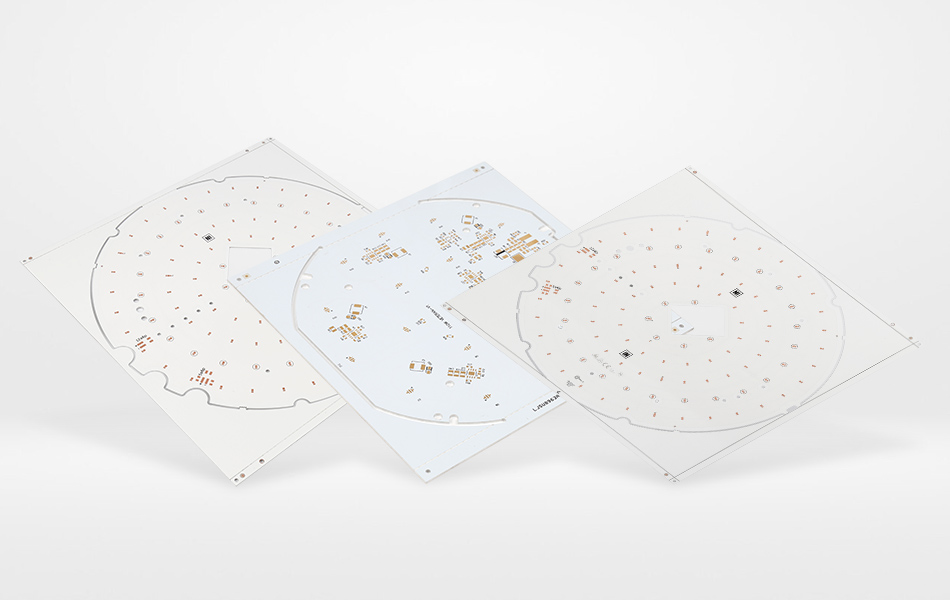
Quality Assurance for 2 Layer Aluminum PCB Prototypes
Electrical Testing
Continuity and Shorts
Using automated test equipment (ATE) or manual multimeters, engineers verify that there are no open circuits or short circuits between layers or traces. This is critical for ensuring the prototype's basic functionality before component assembly.
Impedance Matching
For high - speed signals, impedance testing ensures that trace widths and dielectric thicknesses match the designed impedance values, minimizing signal reflections and distortion.
hermal Testing
Infrared Thermography
Infrared cameras are used to map temperature distribution on the prototype when powered, identifying hotspots and verifying the effectiveness of thermal vias and component placement. This helps engineers optimize the design for better heat dissipation in subsequent iterations.
Thermal Cycling
Prototypes are subjected to repeated temperature cycles (e.g., -40°C to +85°C) to test the durability of the aluminum substrate, dielectric layer, and solder joints, ensuring they can withstand operational temperature fluctuations.
Mechanical Testing
Bend and Vibration Tests
Mechanical tests evaluate the substrate's resistance to bending and vibrations, ensuring the prototype remains intact during handling and real - world use. This is particularly important for portable or automotive prototypes.
Mounting Stability
Testing the integrity of mounting holes and fixtures ensures the prototype can be securely installed in enclosures or test setups without mechanical failure.
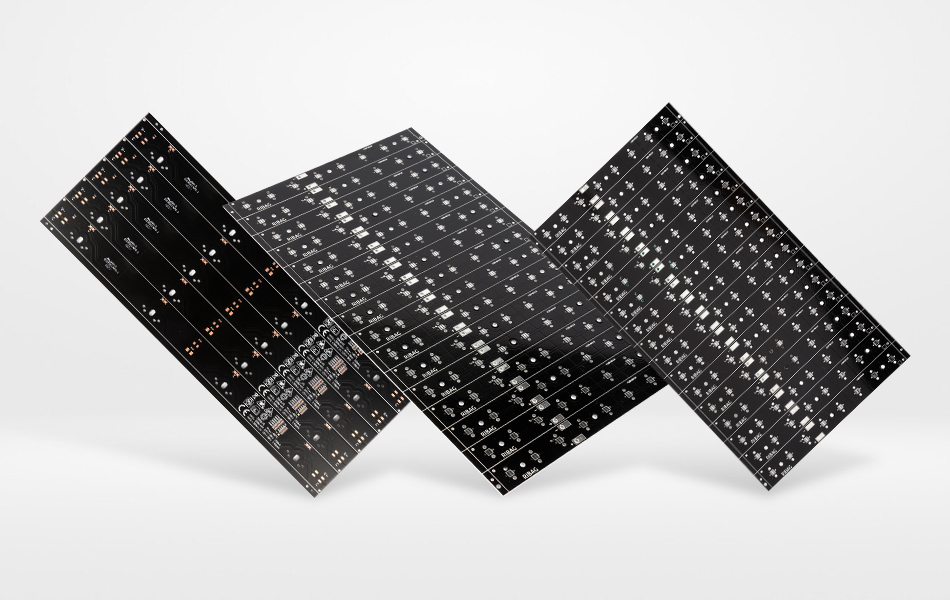
Applications of 2 Layer Aluminum PCB Prototypes
LED Lighting Prototyping
Commercial and Residential Fixtures
Prototypes for LED panels, downlights, or linear fixtures use 2 layer aluminum PCBs to manage heat from LED arrays. The two - layer design allows for straightforward placement of LEDs on the top layer, with the bottom layer serving as a heat sink interface, ensuring uniform light output and extended LED lifespan during testing.
Automotive Lighting
Prototypes for automotive taillights, headlights, or interior lighting leverage the aluminum substrate's vibration resistance and thermal efficiency. The two - layer layout simplifies the integration of LED drivers and thermal management components, critical for meeting automotive reliability standards.
Power Electronics Prototyping
DC - DC Converters
Prototypes for small - to - medium - power DC - DC converters use 2 layer aluminum PCBs to dissipate heat from power transistors and inductors. The bottom layer's ground plane provides a stable reference for high - frequency signals, while the aluminum substrate prevents overheating during load testing.
Battery Management Systems (BMS)
BMS prototypes for electric vehicles or energy storage systems rely on 2 layer aluminum PCBs to manage heat from battery monitoring circuits and power switches, ensuring safe and efficient operation during prototype validation.
Consumer Electronics Prototyping
Portable Devices
Prototypes for laptops, tablets, or wearable devices use 2 layer aluminum PCBs to balance thermal management and compact design. The aluminum substrate helps dissipate heat from processors or batteries, while the two - layer layout allows for efficient routing of high - speed data signals and power traces.
Audio Equipment
Audio amplifiers or soundbars use 2 layer aluminum prototypes to manage heat from power amplifiers, ensuring stable operation and reducing noise interference through proper ground plane design.
Industrial and IoT Prototyping
Industrial Controllers
Prototypes for motor controllers or sensor hubs in industrial automation use 2 layer aluminum PCBs to withstand harsh environments. The aluminum substrate's corrosion resistance and thermal efficiency are critical for maintaining performance in dusty, humid, or high - temperature settings.
IoT Sensors
Compact IoT sensor prototypes benefit from the lightweight and thermal properties of 2 layer aluminum PCBs, ensuring reliable operation in remote or space - constrained locations, such as smart city sensors or environmental monitoring devices.
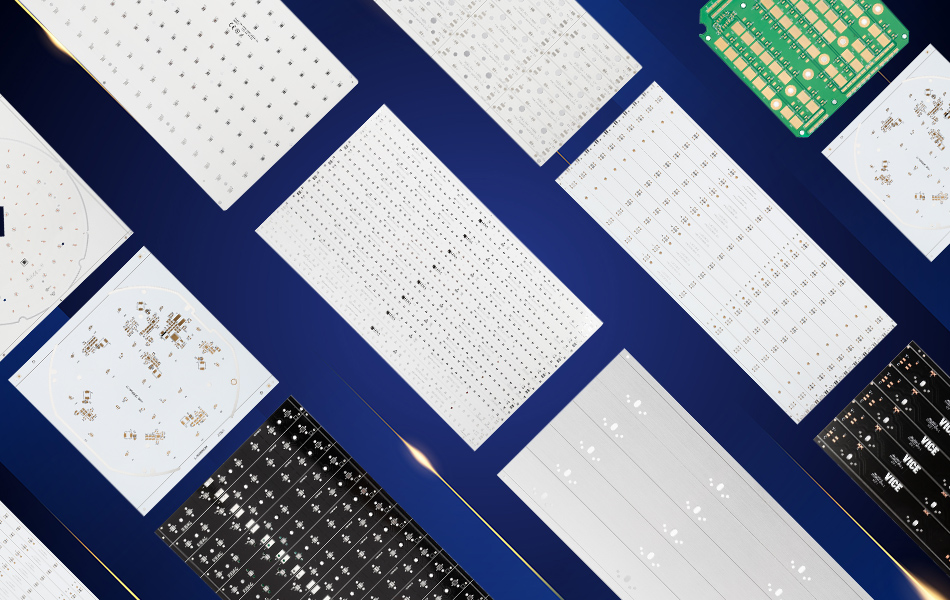
Market Trends and Future Directions
Growing Demand for Rapid Prototyping
The rise of small - batch manufacturing and customized electronics has increased the demand for 2 layer aluminum PCB prototypes. Companies are leveraging these prototypes to quickly validate designs, reduce time - to - market, and minimize risks associated with mass production.
Integration with Advanced Materials
Future prototypes may incorporate advanced dielectric materials with higher thermal conductivity, such as boron nitride nanocomposites, to further enhance heat dissipation in 2 layer designs. These materials could enable smaller form factors for high - power prototypes without compromising performance.
Sustainable Prototyping Practices
Environmental concerns are driving the adoption of recycled aluminum substrates and eco - friendly dielectric materials in prototyping. Manufacturers are also implementing greener etching and plating processes to reduce the environmental impact of 2 layer aluminum PCB production.
Automation in Prototyping
Advanced automation tools, such as AI - powered design assistants and robotic assembly systems, are streamlining the prototyping process. These technologies reduce human error, accelerate design iterations, and enable real - time thermal and electrical simulations for more accurate 2 layer aluminum PCB prototypes.
Conclusion
2 layer aluminum PCB prototypes serve as a vital bridge between conceptual design and mass production, offering a balanced combination of thermal efficiency, cost - effectiveness, and design flexibility. Their role in prototyping spans diverse industries, from LED lighting and power electronics to consumer devices and industrial automation, enabling engineers to validate designs in real - world scenarios. As technology continues to advance, the integration of advanced materials, sustainable practices, and automation will further enhance the capabilities of 2 layer aluminum PCBs, solidifying their position as a cornerstone of modern electronic prototyping. By understanding their engineering fundamentals and practical applications, designers and manufacturers can leverage these prototypes to drive innovation and bring reliable, high - performance products to market efficiently.
In the ever - evolving landscape of modern lighting technology, LED circuits boards have emerged as the linchpin for efficient and innovative illumination solutions. These boards serve as the foundation for powering light - emitting diodes (LEDs), enabling them to deliver superior performance, energy efficiency, and extended lifespan. From residential and commercial settings to specialized applications in automotive, aerospace, and healthcare, LED circuits boards have revolutionized the way we light our world. This article delves deep into the world of LED circuits boards, exploring their material composition, design principles, manufacturing processes, quality assurance measures, diverse applications, and emerging market trends.
Material Composition of LED Circuits Boards
Substrate Materials
The choice of substrate material in LED circuits boards is a critical decision that significantly impacts the overall performance and reliability of the lighting system. Different substrate materials offer distinct advantages, depending on the specific requirements of the application.
Aluminum substrates have gained widespread popularity due to their excellent thermal conductivity. LEDs generate a significant amount of heat during operation, and efficient heat dissipation is crucial for maintaining their performance and lifespan. Aluminum substrates effectively transfer heat away from the LEDs, preventing overheating and ensuring stable operation. Additionally, aluminum offers good mechanical strength and formability, making it suitable for a variety of lighting fixtures.
FR4, a fiberglass - reinforced epoxy laminate, is another commonly used substrate material. It provides good electrical insulation and mechanical stability, making it suitable for applications where cost - effectiveness and standard performance are required. However, FR4 has relatively lower thermal conductivity compared to aluminum, which may limit its use in high - power LED applications where efficient heat dissipation is essential.
Ceramic substrates, such as aluminum nitride (AlN) and aluminum oxide (Al₂O₃), offer superior thermal conductivity and electrical insulation properties. They are ideal for high - power, high - temperature applications where reliable performance and long - term durability are critical. Ceramic substrates can withstand extreme operating conditions, making them suitable for applications in automotive, aerospace, and industrial lighting.
Dielectric Layers
The dielectric layer in LED circuits boards serves as an electrical insulator between the conductive traces and the substrate, while also facilitating heat transfer. The selection of the dielectric material is crucial for optimizing the electrical and thermal performance of the board.
Polyimide - based dielectrics are known for their high - temperature resistance and excellent electrical insulation properties. They can withstand elevated temperatures without significant degradation, making them suitable for high - power LED applications. Polyimide dielectrics also offer low dielectric loss, which helps to minimize signal attenuation and improve the overall efficiency of the circuit.
Ceramic - filled epoxies are another popular choice for dielectric layers. These materials combine the advantages of epoxy resins, such as good adhesion and processability, with the high thermal conductivity of ceramic fillers. Ceramic - filled epoxies provide a cost - effective solution for improving the thermal performance of LED circuits boards, making them suitable for a wide range of applications.
Conductive Traces
Copper is the most commonly used material for the conductive traces in LED circuits boards due to its low electrical resistance and excellent conductivity. The thickness and width of the copper traces are carefully designed to ensure efficient power delivery to the LEDs while minimizing power losses and heat generation.
In high - power LED applications, thicker copper traces are often used to handle the increased current flow. This helps to reduce voltage drops and ensure that each LED receives the appropriate amount of power. Surface treatments, such as electroless nickel immersion gold (ENIG), electroless nickel electroless palladium immersion gold (ENEPIG), and organic solderability preservatives (OSP), are applied to the copper traces to enhance their corrosion resistance, solderability, and long - term reliability.
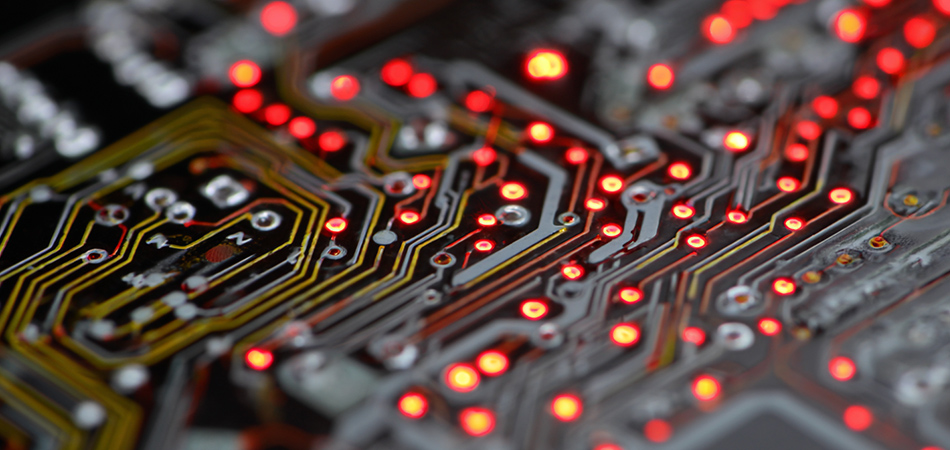
Design Principles of LED Circuits Boards
Thermal Management Design
Thermal management is one of the most critical aspects of LED circuits board design. Effective heat dissipation is essential for maintaining the performance and lifespan of the LEDs, as well as ensuring the overall reliability of the lighting system.
Thermal vias play a crucial role in thermal management by providing a direct pathway for heat to transfer from the LEDs to the substrate. These vias are strategically placed to maximize heat dissipation and minimize thermal resistance. The size, number, and distribution of thermal vias are carefully optimized based on the power requirements and thermal characteristics of the LEDs.
In addition to thermal vias, heat sinks and heat spreaders are often used to enhance heat dissipation. Heat sinks increase the surface area available for heat transfer, while heat spreaders help to evenly distribute the heat across the substrate. The design of the heat sink and heat spreader is optimized to ensure efficient heat transfer and minimize the temperature gradient across the LED array.
Electrical Design
The electrical design of LED circuits boards focuses on ensuring stable and efficient power supply to the LEDs. This includes designing the appropriate current - limiting circuits, voltage regulators, and driver circuits to regulate the current and voltage supplied to the LEDs.
In multi - LED arrays, careful consideration must be given to the electrical configuration of the LEDs, whether in series, parallel, or a combination of both. Series - connected LEDs require a higher voltage but lower current, while parallel - connected LEDs require a lower voltage but higher current. The choice of electrical configuration depends on the specific requirements of the application, such as the desired brightness, color temperature, and power consumption.
Electromagnetic compatibility (EMC) is also an important consideration in the electrical design of LED circuits boards. LED drivers can generate electromagnetic interference (EMI), which may disrupt other electronic devices in the vicinity. Therefore, proper shielding, filtering, and layout techniques are employed to minimize EMI and ensure compliance with EMC standards.
Mechanical Design
The mechanical design of LED circuits boards takes into account factors such as the physical dimensions of the board, the mounting method, and the mechanical stresses it may encounter during operation. The size and shape of the board are determined by the requirements of the lighting fixture and the number and arrangement of the LEDs.
Mounting holes and attachment mechanisms are incorporated into the board design to securely fasten the board to the lighting fixture. The choice of mounting method, such as screw - mounting, snap - fitting, or adhesive bonding, depends on the design of the fixture and the environmental conditions in which the board will operate.
In outdoor or harsh - environment applications, the mechanical design of the board must also consider factors such as resistance to vibration, shock, and corrosion. Reinforcement features, such as stiffeners or protective enclosures, may be added to enhance the mechanical durability of the board.
Optical Design
Optical design is closely intertwined with the electrical and mechanical design of LED circuits boards. The placement and orientation of the LEDs on the board directly affect the light distribution pattern of the lighting fixture. Therefore, careful consideration must be given to the optical design to ensure that the desired light output characteristics are achieved.
Optical components, such as lenses, reflectors, and diffusers, are often used in conjunction with LED circuits boards to control the light distribution and enhance the performance of the lighting system. The design of these optical components is optimized to maximize the light extraction efficiency and minimize light losses.

Manufacturing Processes of LED Circuits Boards
Circuit Board Fabrication
The fabrication of LED circuits boards involves a series of processes, including drilling, plating, lamination, and etching. These processes are carefully controlled to ensure the precision and quality of the board.
Drilling is the first step in the fabrication process, which creates holes for vias, component mounting, and other purposes. Mechanical drilling and laser drilling are the two commonly used methods for drilling holes in circuit boards. Mechanical drilling is a cost - effective method for creating larger holes, while laser drilling offers higher precision and is suitable for creating smaller holes.
Plating is used to deposit a layer of copper on the drilled holes and the surface of the board to ensure electrical conductivity. Electroless plating and electrolytic plating are the two main types of plating processes used in circuit board fabrication. Electroless plating is used to deposit a thin layer of copper on non - conductive surfaces, while electrolytic plating is used to build up the copper layer to the desired thickness.
Lamination is the process of bonding the different layers of the circuit board together, including the substrate, dielectric layer, and copper traces. High - pressure lamination and vacuum lamination are the two commonly used methods for lamination. High - pressure lamination uses heat and pressure to bond the layers together, while vacuum lamination uses a vacuum to remove air bubbles and ensure a uniform bond.
Etching is the process of removing the unwanted copper from the surface of the board to create the desired circuit pattern. Chemical etching and dry etching are the two main types of etching processes used in circuit board fabrication. Chemical etching uses chemicals to dissolve the unwanted copper, while dry etching uses plasma or ion beams to remove the copper.
Component Mounting
After the circuit board is fabricated, the next step is to mount the components onto the board. Surface - mount technology (SMT) is the most commonly used method for mounting components on LED circuits boards. SMT involves placing the components onto the surface of the board using automated pick - and - place machines and then soldering them in place using reflow soldering or wave soldering.
Reflow soldering is the most widely used soldering method for SMT components. It involves heating the board in a reflow oven, which melts the solder paste and creates a strong electrical and mechanical connection between the components and the board. Wave soldering is another soldering method that is commonly used for through - hole components. It involves passing the board over a wave of molten solder, which solders the components in place.
Testing and Quality Assurance
Once the components are mounted on the board, the next step is to test the board to ensure that it meets the required specifications. Electrical testing, optical testing, and thermal testing are the three main types of tests that are performed on LED circuits boards.
Electrical testing involves testing the electrical properties of the board, such as the resistance, capacitance, and impedance of the components and the traces. Optical testing involves testing the light output characteristics of the board, such as the luminous intensity, color temperature, and color rendering index of the LEDs. Thermal testing involves testing the thermal performance of the board, such as the temperature distribution and the heat dissipation efficiency of the LEDs and the substrate.
In addition to these tests, quality assurance measures are also implemented throughout the manufacturing process to ensure the quality and reliability of the boards. These measures include incoming material inspection, in - process inspection, and final inspection.

Applications of LED Circuits Boards
Residential Lighting
LED circuits boards are widely used in residential lighting applications, such as ceiling lights, wall sconces, table lamps, and recessed downlights. The energy - efficiency and long lifespan of LEDs make them an attractive choice for homeowners, as they can significantly reduce energy consumption and maintenance costs.
LED circuits boards also offer a high degree of design flexibility, allowing for the creation of customized lighting solutions that can enhance the ambiance and functionality of any living space. With the ability to control the color, brightness, and intensity of the light, LED circuits boards can be used to create a variety of lighting effects, from warm and cozy to bright and vibrant.
Commercial Lighting
Commercial buildings, such as offices, shopping malls, hotels, and hospitals, also benefit greatly from the use of LED circuits boards. In large - scale commercial applications, the energy savings and reduced maintenance costs offered by LEDs can be substantial, making them a cost - effective lighting solution.
LED circuits boards can be used to create a variety of lighting designs for commercial spaces, including general illumination, task lighting, and accent lighting. They can also be integrated with smart lighting systems, allowing for the control and automation of the lighting based on occupancy, daylight levels, and other factors.
Outdoor Lighting
Outdoor lighting applications, such as streetlights, parking lot lights, landscape lighting, and floodlights, require robust and reliable lighting solutions that can withstand harsh environmental conditions. LED circuits boards are well - suited for outdoor use, as they offer high energy efficiency, long lifespan, and resistance to weather, vibration, and shock.
LED outdoor lighting can also be designed to meet specific lighting requirements, such as brightness, color temperature, and light distribution. With the use of advanced optical components, LED outdoor lighting can provide uniform and efficient illumination, while minimizing light pollution and energy waste.
Automotive Lighting
The automotive industry has witnessed a rapid adoption of LED technology in recent years, and LED circuits boards play a crucial role in this trend. LED headlights, taillights, interior lighting, and daytime running lights are all powered by LED circuits boards, offering improved visibility, energy efficiency, and design flexibility.
LED automotive lighting can also be integrated with advanced driver - assistance systems (ADAS), such as adaptive cruise control, lane departure warning, and automatic emergency braking. By providing precise and reliable lighting, LED circuits boards can enhance the safety and performance of modern vehicles.
Specialized Lighting Applications
LED circuits boards are also used in a variety of specialized lighting applications, such as horticultural lighting, medical lighting, and aviation lighting. In horticultural lighting, LEDs are used to provide the specific wavelengths of light required for plant growth, resulting in increased crop yields and improved plant quality.
In medical lighting, LEDs are used to provide high - quality, flicker - free illumination for surgical procedures, examination rooms, and other medical applications. LED medical lighting can also be designed to meet specific color temperature and color rendering requirements, ensuring accurate diagnosis and treatment.
In aviation lighting, LEDs are used to provide reliable and energy - efficient lighting for aircraft interiors and exteriors. LED aviation lighting can also be integrated with advanced lighting control systems, allowing for the adjustment of the lighting based on the flight phase, cabin conditions, and other factors.

Market Trends of LED Circuits Boards
Growing Demand for Energy - Efficient Lighting
The increasing focus on energy conservation and environmental sustainability is driving the demand for energy - efficient lighting solutions, such as LED circuits boards. Governments around the world are implementing strict energy - efficiency regulations and incentives to promote the adoption of LED lighting, which is expected to fuel the growth of the LED circuits board market in the coming years.
Advancements in LED Technology
The continuous advancements in LED technology, such as the development of high - power, high - efficiency LEDs and the improvement of LED packaging and thermal management, are also contributing to the growth of the LED circuits board market. These advancements are enabling the development of more powerful, efficient, and reliable LED lighting systems, which are expected to expand the application scope of LED circuits boards.
Integration of Smart Lighting Systems
The integration of LED circuits boards with smart lighting systems, such as wireless control, occupancy sensing, and daylight harvesting, is becoming increasingly popular. Smart lighting systems offer a range of benefits, such as energy savings, convenience, and enhanced user experience, which is expected to drive the demand for LED circuits boards in the smart home and commercial building markets.
Growing Demand for Miniaturization and High - Density Integration
The trend towards miniaturization and high - density integration in the electronics industry is also driving the demand for smaller, more compact LED circuits boards. As the size of the LEDs and other components continues to shrink, the design and manufacturing of LED circuits boards need to adapt to accommodate these changes, which is expected to create new opportunities for innovation and growth in the LED circuits board market.
In conclusion, LED circuits boards have become an essential component in the modern lighting industry, offering a wide range of benefits, such as energy efficiency, long lifespan, design flexibility, and reliability. As the demand for energy - efficient lighting solutions continues to grow, and the advancements in LED technology and smart lighting systems continue to evolve, the future of LED circuits boards looks promising. Manufacturers and designers of LED circuits boards need to stay updated with the latest trends and technologies to meet the changing needs of the market and drive the continued growth and innovation of the LED lighting industry.

Step 1: Get in Touch
Click “Skype” button、whatsapp 、info@xunruilyjm.zhu、calling us or sending us “Instant message” through “Request a quote”button,which is on the upper right corner, fill in the email and your message Then you will get an agent from Apollo to get in touch with you and get 50USD PCB coupons immediately.
Step 2: Gerber preview
Send us an email with all the data which is required for the PCB and then Your Agent will send to our engineers team who will preview and evaluate your gerber files and technical specifications,you will get an estimated quote price,the price is nearly 99.5% accurate but may undergo change when re-checking process have been done and found special requirement such as “Copper tended vias”,resign-plug vias,panelization changes etc.Although RS274-X format Gerber data is our standard manufacturing data, we also accept Gerber,PADs, and Eagle file and .PCB file . Please note we will convert your PADs files、.pcb files or Eagle file to Gerber data and then ask for your confirmation before proceeding towards PCB manufacturing line.
Step 3: Order review
After you confirmed orders, our engineer will review the order ASAP. If any issues were found, we will contact you by email or online chat. Please make sure the email address you filled on our website is valid.EQ(if have) and working files will be generated and sent to customers for approval before starting production.
Step 4: How to Pay.
Once the PCB order passes our audit and was confirmed, customers can choose the shipping method and make the payment by PayPal or choose any other available payment methods (We also accept bank transfer,Western union and so on. Please contact us at info@xunruilyjm.zhu for further details if you choose these payment methods). Before paying, please confirm the shipping information you have provided is correct and accurate; especially the address, city name and the corresponding post code.Specially Note:When making payment by bank transfer,please fill our full company name.
Step 5: PCB Fabrication.
The PCB fabrication job will be started immediately once the payment is received and EQ&Gerber files are approved. You can check the manufacture process from the production status provided by our Agent.
Step 6: Delivery:
Once the parcel is shipped out, the tracking number and PI/PL will be sent to you and we will keep you updated with shipping status until you received the goods successfully.
Please note the customs tax fee is different for different countries, before shipping you may consult with your local DHL company or customs office to check the detailed information. Please note the order will be declared as real value or customer requirement; let us know once you place your order (you can change the declared value once you make the payment). Note that all import duties will be on buyers’ account.
Finally, if you still have problem with the order process, please feel free to contact us through online chat、via email: info@xunruilyjm.zhu、by Skype: frank417276767 or call us at:086-755-29438407, we will respond to you as soon as possible within 24 hours. We hope to make our ordering procedure as simple and flexible as possible.
● How to re-order in Apollopcb?
A. Why do you need to re-order?
As we know, different engineers will deal with PCB file in different way so that some details of your new PCB orders will be different. If you want to order the same boards as the samples which you placed in Apollopcb and if you want to save toolings cost(OTC),you need to re-order it instead of placing new order so that your order will be dealt with by the same engineer that operated on your sample order and it will be same as the sample you have been provided with.
B. How to reorder in Apollo?
If you need to reorder the same boards, whose sample order is provided to you by Apollo, follow the steps listed below. Make sure there are no changes in design of your new order and it is same as your previous orders. First, you send emails to your agent and advise part number of your orders. Second, summit repeat orders.If you provided gerber files,our agent and engineers will do the qualifications again and advise if there is any changes on design.We will update the price if we have to setup new toolings due to design changes
PCB Assembly Process
Firstly, you need to send the PCB gerber file, BOM list, Pick and place file. Please note that Gerber,PADs, and Eagle file and .PCB file will be accepted by Apollopcb. If your PCB file is in some other format, please export the Gerber file to us for PCB fabrication. BOM list is a file that contains all components with part number, manufacturer number, specifications, quantity, packages, and legends etc.
We strongly recommend that we perform simple functional tests on your products before shipping them, so that we can guarantee 100% pass rate. We need customers to provide simple test guidelines, we manually or use test fixtures for testing to ensure compliance Shipment of electrical measurement values that meet your requirements.
Secondly, please send us the above mentioned files as mentioned above via email: info@xunruilyjm.zhu. The quotation will come out within 48-72 hours which depends on your components, the PCB complexity and difficulty degree.
● Files needed: Schematic (DSN or PowerLogic), netlist, package, structure chart (DXF), Components file, layout requirements etc.
● Layout and wiring judgment: according to the design standard, design instruction, customer's design requirements and related checklist.
● Layout check and confirm: provide layout file and structure file for customers to check if the layout makes sense and confirm the stack-up program, impedance program, structure and package, also confirm the trace specification.
● Layout file output: PCB original file, Gerber file, pick and place file, framed stencil file and structure file etc. If you have any PCB layout job to get done, don’t hesitate to contact us: info@xunruilyjm.zhu.

Got project ready to assembly? Contact us: info@apollopcb.com



We're not around but we still want to hear from you! Leave us a note:

Leave Message to APOLLOPCB
